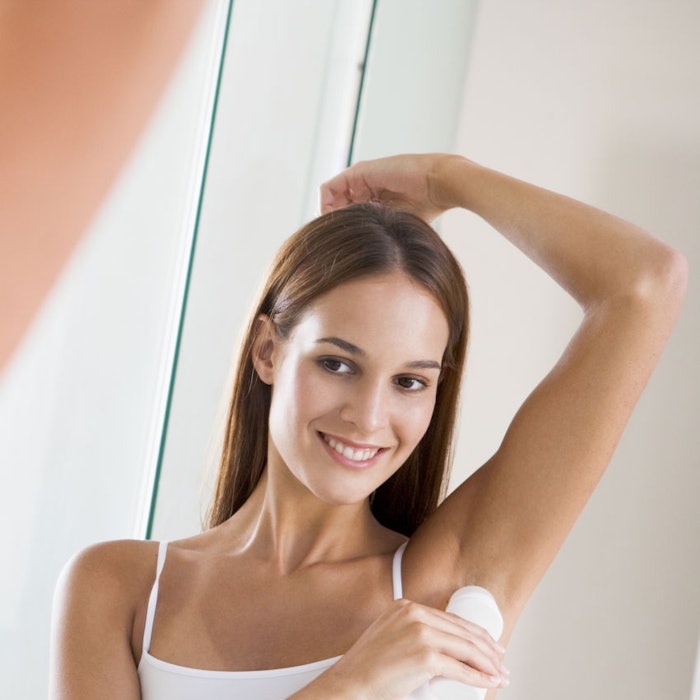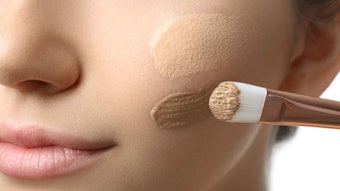
Antiperspirants have been widely used since the mid 1960s. In 1978, the US Food and Drug Administration (FDA) issued a draft monograph (finalized in 1993) on the category, listing these products as drugs—defined as an over-the-counter (OTC) drug when applied topically to reduce production of underarm sweat (perspiration).1 Antiperspirants and deodorants are considered drugs because they can affect the function of the body by reducing the amount of sweat that reaches the skin surface. In the United States, OTC drugs are subjected to monograph rules, which define standards and requirements, pre-market approval process, acceptable actives and allowable formulation percentages of actives. Other countries’ regulations vary in content and scope. Even though most countries have not adopted equal FDA regulatory restrictions, they have adopted some type of general regulatory guidelines that define acceptable safe antiperspirant actives and how to substantiate claims. Even though non-US antiperspirant products are not confined to strict rules, because the FDA monograph has become a template of acceptable antiperspirants, there has been limited innovation in the category globally.
The consumer typically confuses the function of antiperspirants and deodorants, mostly due to a misunderstanding of marketing claims and product positioning. For the most part, antiperspirants are built upon aluminum-based cationic salt chloride complexes, as well as complexes with zirconium acid salts, and are referred to as “actives” on the label. There are numerous types of antiperspirant actives listed in the FDA monograph as well as in the United States Pharmacopeia (USP).2 Antiperspirant actives are responsible for blocking sweat expulsion through the formation of temporary plugs within the sweat duct, thus stopping or slowing down the flow of sweat to the surface of the eccrine gland. The mechanism of sweat reduction is not based on a physiological change to the body. The mechanism is typically described as an occlusive protein-precipitation plug with the acidic nature of the antiperspirant to produce an aluminum or zirconium hydroxide plug. This plug is superficial and readily reversible after 7–28 days without use. The formulation matrix delivery system is the key to effectiveness and acceptable consumer antiperspirant systems. The most common delivery systems are roll-ons (either aqueous or cyclosiloxane suspensions), aerosol (hydrocarbon propellant suspensions), extrudable clear gels (water-in-cyclosiloxane emulsions), extrudable opaque soft solids (anhydrous cyclosiloxane suspension pastes) or solid sticks (anhydrous cyclomethicone suspension solids), as shown in Figure 1.
Key Components: Aluminum Chemistry and Volatile Siloxane
The basic building block of antiperspirant actives is aluminum chemistry, through which elemental aluminum is reduced in an acidic medium to produce what is traditionally known as aluminum chlorohydrate (ACH) with an atomic ratio of 2:1 aluminum to chloride. These inorganic cationic polymer salts are classified as octahedral complexes of a basic aluminum hydroxide, stabilized with an anionic chloride to maintain their water solubility. Within the monograph boundaries, the atomic ratio of aluminum to chloride can range from 2:1 to 1:1 within three different segmentations (aluminum chlorohydrate, aluminum sesquichlorohydrate and aluminum dichlorohydrate, as pictured in Figure 2. Antiperspirant actives can also be complexed with hydrated acidic zirconium cationic salts of chloride to make what is traditionally known as aluminum zirconium chlorohydrate (ZAG or AZG). Like ACHs, AZGs can have various ratios of atomic aluminum to zirconium of 2:1 to 10:1 and atomic total metals to chloride of 0.9:1 to 2.0:1. As shown in Figure 3, these AZG complexes can be buffered with glycine (an amino acid) to stabilize the complex and mitigate the acidic harshness which could result when applied to underarm axilla.4 Another key component for most antiperspirant formulations is a volatile siloxane, typically cyclomethicone (INCI: Cyclopentasiloxane). With the advent of concerns on environmental and human exposure to these cyclosiloxanes, there is a search for alternative volatile carriers. Cyclosiloxanes have a unique performance profile; they are 100% transient emollients that are volatile at body temperature, non-volatile organic compounds (VOC), non-cooling during evaporation, non-irritating (important for people who shave their underarms) and non-reactive and compatible with most formulation ingredients. There are other important siloxanes that serve varying functional benefits as noted in Figure 4.
Recent Patents
It is interesting that the antiperspirant category represents large retail sales but limited patent activity. This may be because the category is primarily restricted by governmental regulations, requiring a costly process for new drug application (NDA). Still, even with this limitation, there is still activity of value-added efficacy improvements and aesthetic enhancement.
Organosiloxane-oxyalkylene copolymer release: For commercial anhydrous antiperspirant compositions, the antiperspirant active substance suspended in the anhydrous oil-containing carrier is covered with an oil layer.5 This oil layer delays the release of antiperspirant active substance in the effective water-soluble form. The object of the present invention was therefore to prepare anhydrous antiperspirant compositions that have improved release of the antiperspirant active and antiperspirant performance.
It was found that the release of the antiperspirant active substance from an anhydrous antiperspirant composition may be improved if at least one organosiloxane-oxyalkylene copolymer is contained. The object of the present invention is to create an antiperspirant composition that: is non-aerosol; is a stick, cream, gel, suspension, solution or as a substrate impregnated with a composition; contains at least one antiperspirant active substance; contains at least one oil liquid under normal conditions as a carrier; contains 0–3% w/w, preferably 0–2% w/w, of free water, based on the weight of the composition; and contains at least one organosiloxane-oxyalkylene copolymer.
Analytical techniques for particle management: In an attempt to increase the quality and quantity of smaller aluminum (Al) and/or zirconium (Zr) species, a number of efforts have focused on: how to select the components of ACH and ZAG that affect the performance of these materials as antiperspirants; and how to manipulate these components to obtain and/or maintain the presence of smaller types of these components.6 These attempts have included the development of analytical techniques to identify the components. Size exclusion chromatography (SEC) or gel permeation chromatography (GPC) are methods frequently used for obtaining information on polymer distribution in antiperspirant salt solutions. With appropriate chromatographic columns, generally five distinctive groups of polymer species can be detected in commercial ACH and ZAG complexes appearing in a chromatogram as peaks 1, 2, 3, 4 and a peak known as “5,6.” Peak 1 is the larger Zr species (greater than 60 Angstroms). Peaks 2 and 3 are larger aluminum species. Peak 4 is smaller aluminum species (aluminum oligomers, or small aluminum cluster) and has been correlated with enhanced efficacy for both Al and Al/Zr salts. Peak 5, 6 is the smallest aluminum species. Various analytical approaches for characterizing the peaks of ACH and various types of ZAG actives are found in further reading.7
The present invention provides for a method of making an antiperspirant active composition. The first step of the method involves heating an aqueous solution of an aluminum salt with an aluminum to chloride molar ratio of ~0.3:1–3:1, optionally with a buffer agent, at a temperature of about 50–100°C to reflux for ~1–6 hours to obtain an aluminum salt solution. Secondly, an aqueous solution of sodium hydroxide is added to obtain an aluminum salt solution with an OH: Al molar ratio of ~2:1–2.6:1 to obtain a pH adjusted aluminum salt solution with a pH of ~2–5. Thirdly, a calcium ion is provided, and the optional addition of an aqueous solution containing a zirconium compound adjusted aluminum salt solution to obtain an Al-Zr salt solution with a molar ratio of Al to Zr of ~5:1–10:1 is the last step in the method.
Mimicking deodorant feel in antiperspirants: Some antiperspirant emulsion formulas exhibit the feel of deodorants with minimal crumbling or caking.8 Such products typically include an emulsion of an aqueous phase containing an active antiperspirant compound, such as an antiperspirant metal salt, and an oil phase containing a volatile silicone, fragrances, gellants and other additives. While such formulas may provide the preferred glide of deodorants, conventional antiperspirant emulsions do not exhibit the antiperspirant efficacy that solid wax antiperspirant sticks do. Once introduced into the water phase, the antiperspirant salt experiences at least some loss of functionality. Accordingly, it is desirable to provide antiperspirant emulsion products that exhibit improved antiperspirant efficacy and that have the feel of deodorants. In addition, it is desirable to provide processes for making such antiperspirant emulsion products.
In accordance, a w/o antiperspirant emulsion product is provided. The water phase comprises an activated aluminum sesquichlorohydrate active system, propylene glycol and water. The oil phase comprises cetyl PEG/PPG-10/1 dimeth-icone and a hydrophobic carrier, C12–15 alkyl benzoate, high molecular weight polyethylene, synthetic wax, dimethicone and optional cyclohexasiloxane.
Hyperhidrosis treatment: The present invention is a composition for the treatment of hyperhidrosis. The composition contains an effective amount of an antiperspirant.9 In particular, one embodiment of the composition includes an antiperspirant, at least one muscle relaxing agent, at least one peptide and at least one botanical agent. The composition is applied to a substrate. In another non-limiting illustration, the composition includes from ~0.001–50.0 % w/w aluminum zirconium tetrachlorohydrex glycine (AZG), (preferably ~19.0 % w/w AZG) glycerin, dipeptide diaminobutyroyl benzylamide diacetate, gamma amino butyric acid, Solanum lycopersicum (tomato) extract, Gynostemma pentaphyllum extract, Panax ginseng root extract, Portulaca oleracea extract, butylene glycol, denatured alcohol and water.
Polyelectrolyte complex antiperspirant: The present application relates to an antiperspirant composition containing an active ingredient and a polyelectrolyte (PEC) complex comprised of a cationic polyquaternium polymer and an anionic polymer.10 The anionic polymers include those polyacids containing mono-, di- or tri-acid monomers or their neutralized salts. Another aspect of the present invention, the cationic polymer and anionic polymer are present at a charge ratio of ~0.70–1.80, more particularly from ~0.90–1.50, respectively. Polyelectrolyte complexes (PEC) between anionic and cationic polymers form micro-gels. The antiperspirant composition of the present invention may take the form of an antiperspirant stick, lotion, cream, roll-on, solution or aerosol.
Recent Commercial Product Launches
The antiperspirant category has employed a limited number of delivery systems. For the most part the technology has not changed much over the past 15–20 years, but there have been subtle changes, particularly with structurants, emulsifiers and additional functional non-antiperspirant ingredients. The commercial examples represent current technology approaches to delivering wetness and odor control to the axilla.
Degree MotionSENSE Antiperspirant Deodorant Invisible Solid: This antiperspirant, shown in Figure 5, is targeted to women and utilizes a micro-encapsulated fragrance technology to release freshness when the consumer is active. The product reportedly offers 24-hour wetness and odor protection. The ingredients incorporated into the deodorant and their approximate concentrations is shown in Table 1.
Secret Clinical Strength Waterproof Antiperspirant Deodorant: This product, shown in Figure 6, is said to provide waterproof wetness protection that outlasts heat, humidity and water. The product contains the company’s H2OGuard technology, which is said to provide three layers of protection: waterproof wetness protection; odor- absorbing capsules that respond to heat and humidity; and skin soothing conditioners. Additional ingredients in the formulation and their approximate concentrations are illustrated in Table 2.
Arrid Ultima Clinical Protection Clean Mist Antiperspirant Deodorant Spray: This spray (Figure 7) features a non-irritating clinical protection formula with the skin conditioners isopropyl myristate and cyclopentasiloxane that is claimed to go on clear without white residue and to protect against odor and wetness. A detailed list of ingredients and their approxiate concentrations is given in Table 3.
Right Guard Sport 3-D Odor Defense Cool Clear Gel Antiperspirant & Deodorant: This antiperspirant, pictured in Figure 8, has been released with a new formula that is said to block 100% more odors. The product is described as a sweat and odor blocker for up to 24-hour protection. This formula, shown in Table 4 with approximate concentrations, is an example of utilizing water phase refractive index adjusting agents (alcohol and propylene glycol). It is also an example of clear gels using a w/s emulsifier (PEG/PPG-18/18 dimethicone) and hydrating salt (calcium chloride) to develop stable emulsions.
Dry Idea Advanced Dry Unscented 24hr Antiperspirant & Deodorant Roll-On: This roll-on (Figure 9) features a new formula with hypoallergenic protection and fast-drying MicroCotton, which possibly is comprised of cotton seed oil and corn starch. The ingredients along with their approximate concentrations are listed in Table 5.
Nivea Invisible Black & White Clear Antiperspirant Roll-On: This roll-on, shown in Figure 10, is said to offer gentle care and 24-hour protection against odor and wetness. It reportedly leaves no white marks on dark clothing and no yellow stains on white clothing. This formulation, shown in Table 6 with approximate concentrations, combines the surfactant emulsifiers isoceteth-20, glyceryl isostearate and PEG-150 distearate with the surfactant deodorant palmitamidopropyl trimonium chloride to provide a mild skin conditioning along with antiperspirancy.
Formulator Beware
The category continues to go through minor evolutionary changes as consumer marketing companies continue to look for ways to differentiate their products. The consumer is satisfied with the wetness and odor-controlling effectiveness. The subtle changes revolve around improved non-whitening, moisturization skin conditioning and extra benefits such as reduced shaving.
Formulating with antiperspirant actives is relatively easy, but there is a need to watch basicity. Antiperspirant actives are acidic and could precipitate in the presence of a pH above 7.0. In anhydrous systems, it is best to suspend in cyclopentasiloxane and homogenize to produce a uniform dispersed particle to reduce whitening and grittiness. Another issue of concern is the wax matrix and its ability to reduce mobility of the antiperspirant active in the presence of underarm moisture, thus reducing maximum efficacy potential.
The industry continues to see pressure for alternative technology in antiperspirants that is not dependent on metallic salts, because some consider them non-natural or associate them with breast cancer11 and Alzheimer’s disease. Lately, there is a growing concern for the perceived safety of parabens and triclosan (a widely used deodorant). Fortunately, there is no scientific data to associate antiperspirant actives to any safety or environmental issues.
References
Send e-mail to [email protected].
1. Antiperspirant Drug Products for Over-the-Counter Human Use, US Department of Health and Human Services, US Food and Drug Administration, Final Rule, 68 CFR, Part 110 (2003), www.fda.gov/downloads/Drugs/DevelopmentApprovalProcess/Development Resources/Over-the-CounterOTCDrugs/StatusofOTCRulemakings/ucm110774.pdf (Accessed Sep 26, 2011)
2. USP 27/NF 22 (2004) United States Pharmacopeial Convention, Rockville, MD, pp 83–91, 93–106
3. E Abrutyn, Antiperspirant and deodorants: Fundamental understanding, IFSCC Monograph Series No. 6, Micelle Press: Weymouth, Dorset, UK (1998)
4. E Abrutyn, Antiperspirant and deodorants, in Harry’s Cosmetology, 8th ed, MM Reiger, ed, Chemical Publishing Company Inc., New York, USA (2000)
5. US Patent Application 20100260698, Anhydrous antiperspirant compositions with improved active substance release, C Galente, B Banowski and N Buse (Oct 14, 2010)
6. US Patent Application 20110182841, Method of making an antiperspirant active composition having SEC chromatogram exhibiting high SEC peak 4 intensity, L Pan and L Kilpatrick-Liverman, assigned to the Colgate-Palmolive Company (Jul 28, 2011)
7. AH Rosenberg, Antiperspirant Actives—enhanced efficacy aluminum-zirconium-glycine (AZG) salts in Cosmetics and Toiletries Manufacture Worldwide, DC Fondots, ed, Aston Publishing Group, Hartfordshire, UK (1993) 252, 254–256
8. US Patent Application 20110038823, Antiperspirant emulsion products with improved efficacy and processes for making the same, B Phipps and T Doering, assigned to the Dial Corp. (Feb 17, 2011)
9. US Patent Application 20110020415, Composition for treatment of hyperhidrosis, A Kunin (Jan 27, 2011)
10. US Patent Application 20100297201, Use of polyelectrolyte complexes in antiperspirant technology, TW Gillece, LC Foltis, DF Koelmel, AN Luschen and CM Barrett (Nov 25, 2010)
11. DK Mirick, S Davis and DB Thomas, Antiperspirant use and the risk of breast cancer, J Natl Cancer Inst 94(20) 1578–80 (2002), http://jncicancerspectrum.oxfordjournals.org/cgi/reprint/jnci;94/20/1578.pdf (Accessed Sep 26, 2011)










